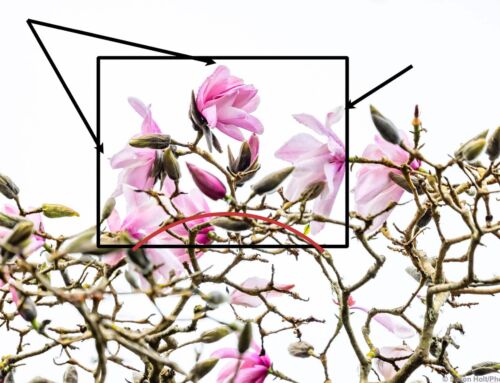No, this is not a gardening tip on how to prune trees, it is about careful cropping of a photograph.

Spring flowering ‘Liset’ crabapple tree, (Malus) in San Francisco Botanical Garden with daffodils.
I have been photographing these ‘Liset’ Crabapple trees for many years. They are centrally located in the San Francisco Botanical Garden on a small hill in the Great Meadow. Three trees are close together, providing all sorts potential for composing a photograph.
Careful composition starts with using the full frame of the camera, using the four edges of the viewfinder to define the edges – a canvas to be filled. But don’t let that predetermined rectangle of your viewfinder limit your composition. It is so easy to crop a photograph later with even the simplest tools.
Camera manufacturers have three basic file-size formats or aspect ratios – 3:2, 4:3, and 1:1. A classic full frame SLR camera is 3:2, the classic golden ratio rectangle of professional 35mm cameras, 3 wide by 2 high.
This first picture is full frame, 3 to 2 on my Canon camera:
I am not happy with this composition: it is a little bit too wide. I don’t like the asphalt pathway creeping in on the left, nor the piece of lawn on the far right. If I try to come in tighter, using the default 3 to 2 ratio, I lose the top to bottom proportions of tree and daffodils that seem just right.
A 4:3 ratio is much more satisfying.
This aspect ratio of many modern and compact cameras, sometimes referred to as four thirds, is the same ratio as the traditional television screen – before flat screens and panorama displays. This is the crop that I knew I needed to make and fills up the frame more completely with no wasted space.
But there is another crop to be considered. Square.
Some very high end cameras use the 1:1 aspect ratio, and square is also the default size for Instagram. I find it hard to compose well in square, I see things in rectangles, but in analyzing a scene the photographer needs to be conscious of the precise cropping that will tell the precise story.
As I stood at that spot I realized there was a another story to tell, the story of how these crabapples fit into the larger garden. A wider view would show a garden path and bench. It becomes much more obvious that this is a public garden and these silent beauties await discovery.
A full frame 3:2 cropping is little more than a pretty snapshot, but I knew I could crop it into a more panorama, wide view.
Before and After Slider
Always take the time to study a beautiful garden with your camera and imagine how you can fill the frame of your final composition. Don’t let the camera tell you how to crop what you see.
More tips in Think Like a Camera e-book: $9.95 in our Store.











Leave A Comment